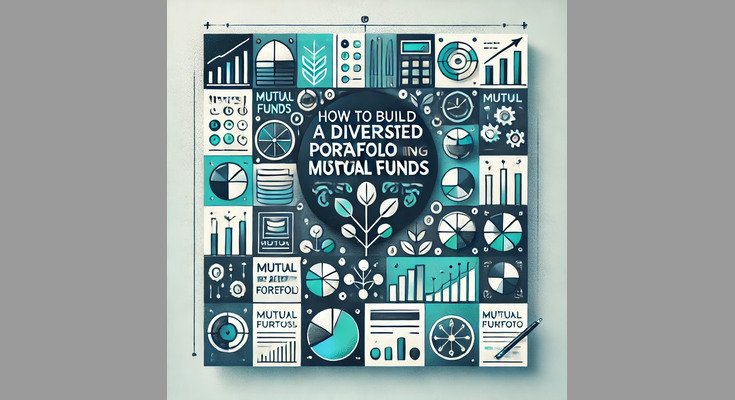How to Build a Diversified Portfolio Using Mutual Funds

Investing wisely is key to achieving long-term financial stability. One of the most effective ways to maximize returns while managing risk is by creating a diversified portfolio using mutual funds. Diversification ensures that your investments are spread across different asset classes, sectors, and geographies, reducing the impact of underperformance in any single area.
This guide will walk you through the process of building a diversified portfolio using mutual funds, its importance, and practical steps for Indian investors.
Why a Diversified Portfolio Using Mutual Funds Is Essential
1. Risk Management
A diversified portfolio using mutual funds helps mitigate risks by spreading investments across various categories. If one sector underperforms, others may balance the losses.
Example: During the COVID-19 pandemic, pharma funds outperformed, while other sectors struggled. A diversified portfolio using mutual funds would have balanced these fluctuations.
2. Consistent Returns
By investing across different asset classes and sectors, you can achieve steady long-term returns, reducing volatility.
3. Alignment with Financial Goals
A diversified portfolio using mutual funds ensures that your investments cater to different financial objectives, such as short-term liquidity, medium-term growth, and long-term wealth creation.
Steps to Build a Diversified Portfolio Using Mutual Funds
1. Define Your Financial Goals
Before selecting mutual funds, identify your investment objectives:
- Short-Term Goals (1-3 years): Emergency funds, vacation planning.
- Medium-Term Goals (3-5 years): Buying a car, saving for a wedding.
- Long-Term Goals (5+ years): Retirement, children’s education.
2. Assess Your Risk Tolerance
Your risk appetite determines the allocation between equity, debt, and hybrid funds:
- High Risk: Higher allocation to equity funds.
- Moderate Risk: Balanced allocation to equity and debt.
- Low Risk: Greater focus on debt and hybrid funds.
3. Allocate Across Asset Classes
A diversified portfolio using mutual funds includes:
- Equity Funds – For long-term growth.
- Debt Funds – For stability and predictable returns.
- Hybrid Funds – For balanced risk and growth.
- Gold Funds – For hedging against inflation.
- International Funds – For geographic diversification.
Diversifying Within Equity Mutual Funds
Equity funds play a crucial role in a diversified portfolio using mutual funds, but diversification within equity is equally important.
1. Large-Cap Funds
Invest in well-established companies for stable and consistent returns.
Example: Axis Bluechip Fund.
2. Mid-Cap Funds
Target medium-sized companies with high growth potential but higher risk.
Example: DSP Midcap Fund.
3. Small-Cap Funds
Invest in smaller companies with exponential growth potential but greater volatility.
Example: Nippon India Small Cap Fund.
4. Sectoral and Thematic Funds
Focused investments in specific industries or themes. Use them strategically.
Example: ICICI Prudential Technology Fund.
5. Index Funds
Passive funds tracking benchmark indices like Nifty 50 or Sensex.
Example: UTI Nifty 50 Index Fund.
Diversifying Within Debt Mutual Funds
Debt funds add stability to a diversified portfolio using mutual funds, providing steady returns.
1. Liquid Funds
Ideal for short-term goals and emergency funds.
Example: HDFC Liquid Fund.
2. Short-Duration Funds
Best for medium-term stability.
Example: SBI Magnum Ultra Short Duration Fund.
3. Corporate Bond Funds
Invest in high-rated corporate bonds for steady returns.
Example: ICICI Prudential Corporate Bond Fund.
4. Gilt Funds
Government securities with moderate returns and low risk.
Example: Nippon India Gilt Securities Fund.
Diversifying Within Hybrid Funds
Hybrid funds blend equity and debt, ensuring balanced risk and returns.
1. Aggressive Hybrid Funds
Higher allocation to equity for higher returns.
Example: Mirae Asset Hybrid Equity Fund.
2. Conservative Hybrid Funds
Greater focus on debt for lower volatility.
Example: ICICI Prudential Balanced Advantage Fund.
Adding Geographic Diversification
International mutual funds offer exposure to global markets, strengthening a diversified portfolio using mutual funds.
1. US Equity Funds
Invest in global giants like Apple, Microsoft, and Google.
Example: Motilal Oswal Nasdaq 100 ETF.
2. Global Thematic Funds
Focus on global trends such as technology and ESG.
Example: Edelweiss Greater China Equity Offshore Fund.
Practical Indian Portfolio Example
Here’s a sample diversified portfolio using mutual funds for a 35-year-old investor with moderate risk tolerance:
| Category | Fund Name | Allocation |
|---|---|---|
| Large-Cap Equity Fund | Axis Bluechip Fund | 25% |
| Mid-Cap Equity Fund | DSP Midcap Fund | 20% |
| Debt Fund | ICICI Prudential Corporate Bond Fund | 20% |
| International Fund | Motilal Oswal Nasdaq 100 ETF | 15% |
| Gold Fund | SBI Gold Fund | 10% |
| Hybrid Fund | Mirae Asset Hybrid Equity Fund | 10% |
Monitoring and Rebalancing Your Portfolio
1. Review Regularly
Monitor your diversified portfolio using mutual funds at least once a year.
2. Rebalance Periodically
Adjust allocations if any category deviates significantly from the desired proportion.
Common Mistakes to Avoid
1. Over-Diversification
Holding too many funds can dilute returns and make tracking difficult. Stick to 6-10 funds.
2. Ignoring Risk
Investing heavily in high-risk funds without understanding volatility can backfire.
3. Chasing Past Performance
Prioritize consistent performers over funds with recent high returns.
Conclusion
Building a diversified portfolio using mutual funds is crucial for financial stability and long-term growth. By spreading investments across asset classes, sectors, and geographies, you can minimize risks while optimizing returns.
Always align your portfolio with financial goals, monitor performance regularly, and rebalance when necessary. With the right strategy, a diversified portfolio using mutual funds can set you on the path to financial success.
For expert financial insights, visit Rich Path. and start your investment journey today! 🚀
Read more –
Top 5 Mutual Funds for Long-Term Growth in India in 2025
Best Mutual Funds: How to Choose – A Complete Guide
Best Flexi Cap Mutual Funds to Invest in 2025
Disclaimer
The information in this article is for educational purposes only and should not be considered financial advice. Mutual fund investments are subject to market risks, and past performance is not indicative of future results. Consult a certified financial advisor before making investment decisions. The examples provided are for illustrative purposes and may not reflect actual outcomes. Tax laws are subject to change. The author and publisher are not responsible for financial losses or legal implications arising from this information.








